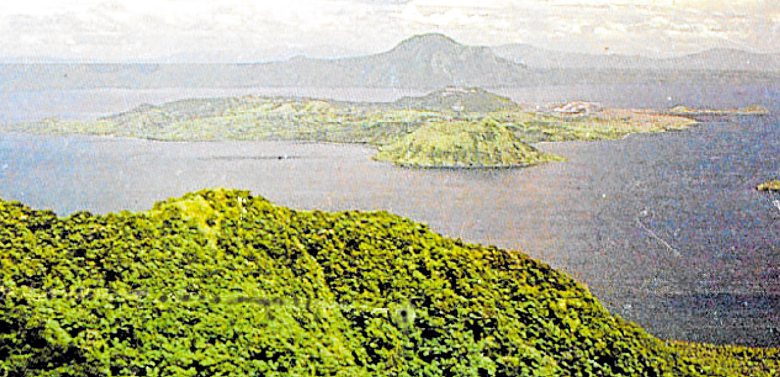Taal settlers live while danger lurks

CONSTANT ALERT LEVEL Taal Volcano’s lethal history has not stopped migrants from other provinces from settling on the
fringes of the island. —PHILVOLCS PHOTO
Taal, one of the world’s smallest but deadliest active volcanoes, has claimed some 5,000 lives in the 33 times that it has erupted.
But the volcano’s lethal history has not stopped migrants from other provinces from settling on the fringes of the volcano island, swelling its population from 5,500 in the early 1990s to more than 10,000, according to the Batangas Provincial Disaster Risk Reduction and Management Office (BPDRRMO).“We have repeatedly warned volcano settlers that they’re living with danger,” said Renato Solidum Jr., head of the Philippine Institute of Volcanology and Seismology (Phivolcs), as the 2,475-hectare island has been marked a “permanent danger zone,” or PDZ, as early as the 1950s by Phivolcs’ predecessor, the Commission on Volcanology.
A PDZ is “definitely not suitable for human settlement at all times because the risk of staying there is very high,” said Solidum of Taal, one of the country’s 23 active volcanoes which last erupted on Oct. 3, 1977.
Already, more than 4,850 earthquakes ranging from Intensity 1 to 3, as well as increases in gas emissions, have been recorded by Phivolcs in the volcano area.No police powers
“It makes perfect sense to prohibit outsiders from staying on the PDZ permanently,” Solidum said. He added, however, that “with no police powers, the agency can’t stop people from moving to the island. It’s not our job. We can only recommend to higher authorities and local government units (LGUs) to keep the area off-limits to permanent settlers.”
Phivolcs personnel, he recalled, had earlier vacated the agency’s observatory at Pira-Piraso Point [on the island] as a way of “telling the locals that Taal is really very dangerous,” Solidum said.
As such, the volcano has become “one of the most instrumented not just in the region but in the world, with an array of seismic, ground monitoring and other instruments,” constantly checking what’s happening in both the island and the caldera, the crater created during a huge prehistoric eruption.
“We’re also putting up infrasound, which is like a microphone to detect the rumbling sounds of Taal,” Solidum said.
“Many volcano settlers seem fearless, with no sense of urgency, because they didn’t know what happened in the past,” he said, referring to Taal’s biggest recorded eruption in 1754, when the volcano vented its fury for over six months.
That eruption was “not only vertical, but also crossed sideways and went up the hill,” Solidum said. The huge lava flow surged into Balayan Bay and transformed a channel into what became the 267-square-kilometer Taal Lake, submerging entire towns in its path.Hazard maps
Fearing that the 1754 eruption could happen again, Phivolcs has created worst-case scenario hazard maps based on the natural disaster.
Despite being a tourist attraction and a source of livelihood to settlers, Taal Volcano’s PDZ should be declared “no man’s land,” said lawyer Kimberly Dyane Garcia, chief of the BPDRRMO planning and research division.
Her office is pushing for the passage of one such Sangguniang Panlalawigan measure. This would require prior consultation with LGUs, as well as a huge budget for the relocation of island residents to safer areas in the province, Garcia said.
The BPDRRMO had earlier crafted a contingency plan covering not just disaster preparedness and risk reduction, but also the provision of emergency services and aid to evacuees in the event of Taal’s eruption. The scenario will cover more than 74,000 families in nearly 200 villages in the lakeshore towns and cities within the 17-km radius from the volcano.
Already, three primary schools on the PDZ have transferred classes to the nearest schools in the lakeshore towns of Agoncillo, Balete and Talisay based on a Department of Education-Batangas directive.
Park site purposes
The volcano island was initially reserved for “park site purposes” based on Proclamation No. 235 issued by then President Ferdinand Marcos in 1967. But President Fidel Ramos amended the Marcos directive in 1996, allowing the park to “provide sustainable livelihood opportunities to tenured migrants without necessarily defacing the natural features of the area.”
That became an irresistible lure to poor migrant families who started settling on the island, planting corn, cassava and other root crops on the rich volcanic soil, fishing and engaging in ecotourism activities, including renting out pumpboats and horses to tourists on their way to the crater’s view decks.
The settlers have flourished despite there being no electricity on the island. Residents instead procure small generator sets and solar kits. For water, they turn to deep wells.
Said Emmanuel Onal, head teacher in the 218-pupil kindergarten and primary school in Alas-as: “We get the water at night. It’s hot so it needs to be cooled down overnight so we can drink it in the morning.”
State of alertness
While the advantages of staying on the island outweigh the risks, Ona’s coteacher Randel Cantos admitted that they are on a “constant state of alertness,” with Alas-as village chief Jocelyn Bayanay citing “signs of imminent eruption,” like an increase in the frequency of tremors and gas emissions, ground swelling, and deep rumblings known as “kurok.”
Farmer Apolinario Tenorio, 60, said they “also watch for unusual behavior in dogs and horses when they sense danger.”
People’s fears have abated somewhat, what with today’s cell phone technology and other gadgets providing constant, speedy and accurate updates from Phivolcs and other disaster agencies, said Bayani de Sagun, San Nicolas disaster risk reduction and management officer.
Like other active volcanoes worldwide that continue to attract thousands of visitors, Taal remains a centerpiece of tourism programs in Batangas province. But it is closed to local and foreign visitors when it is behaving abnormally and there is a threat of imminent eruption, said San Nicolas tourism officer Melanie Pili.
“What’s important is that people know when to leave the island before an eruption,” said Pili and cassava trader Alvin Pepito.